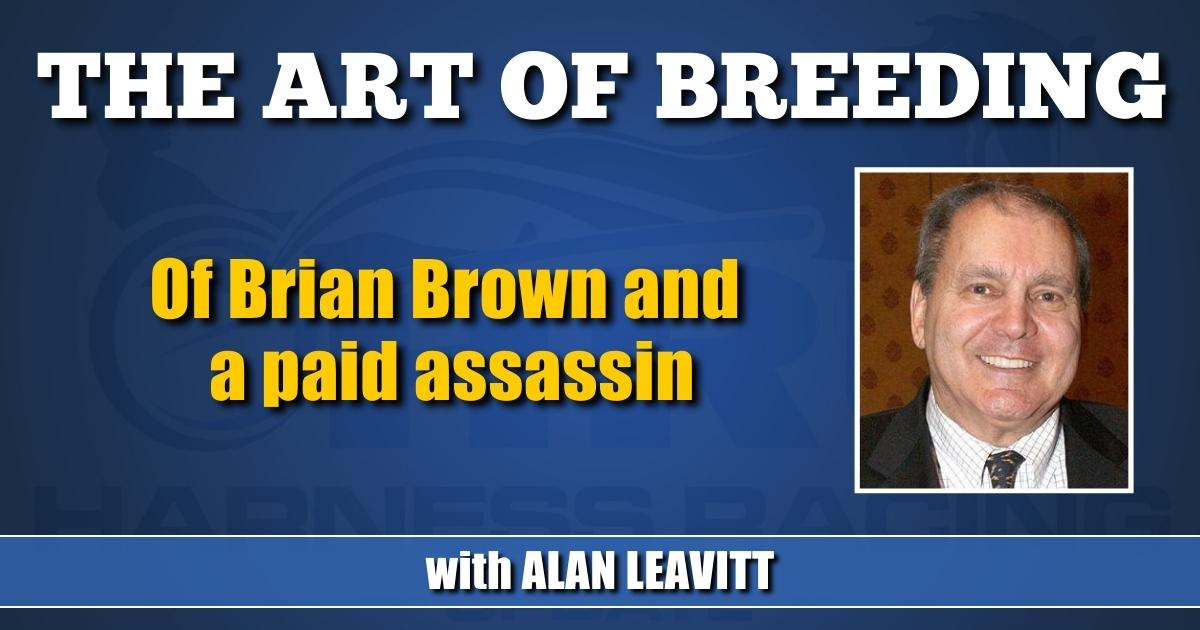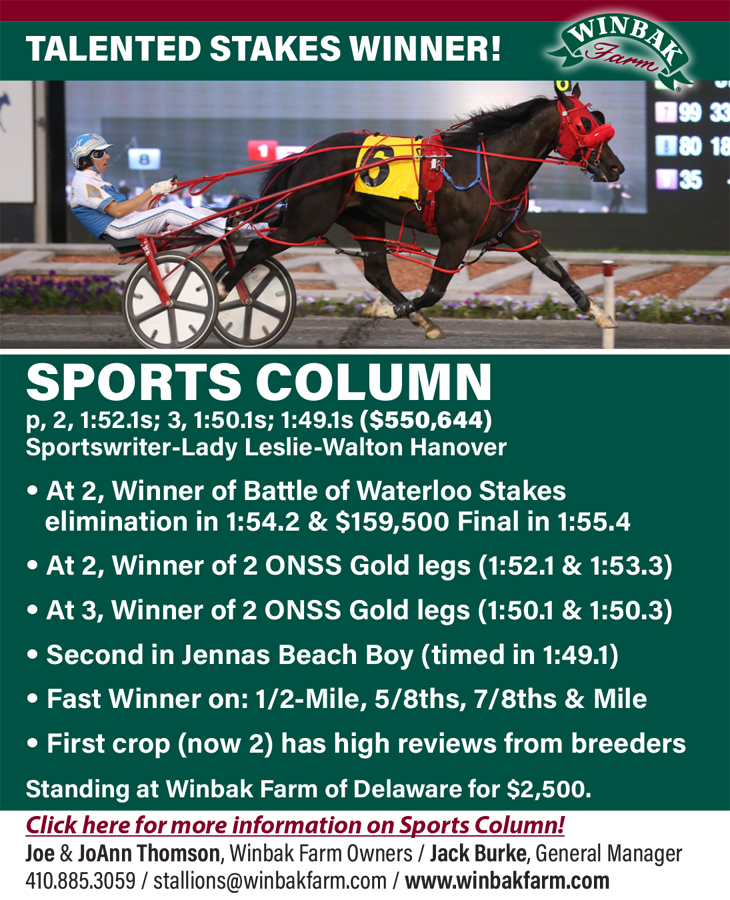Of Brian Brown and a paid assassin
by Alan Leavitt
Having read an interesting piece about a 3-year-old pacing filly named Trick Of The Light, I compulsively ran her five-generation pedigree on the USTA’s Pathway. But before we look at that, a word about two of the people responsible for this filly who already has a record at 3 of 1:50 and earnings of $362,150.
Trick Of The Light is trained by Brian Brown, who to me is one of our sport’s best kept secrets when it comes to top trainers. His home base is somewhere in Ohio, where he does a lot of damage in the sire stakes there, but he more than holds his own on the biggest stage of our sport, with wins in both the Jugette and the Breeders Crown.
It’s not my purpose to write ads for either horses or trainers, but as an objective observer, I regard Brown as an under-tapped resource when it comes to top trainers.
Back to Brown’s filly, Trick Of The Light, she’s by Odds On Equuleus and out of Gordjus, by Dragon Again. (Just say her dam’s name out loud and you’ll see it’s a clever spelling of a very complimentary adjective).
Odds On Equuleus is owned by Dana Parham, whom I have gotten to know and am proud to claim as a friend. For 15 years, Parham and his group bet $50 million or more every year on harness races. From this fact alone it is obvious he is more knowledgeable about betting on harness races than anyone else alive today.
Parham is also, as I soon found out, totally open to sharing his expertise with anyone who asks him a question. To the eternal shame of the people running our racetracks, not one of them has ever broached a question to Parham, or asked for his advice. I know that some tracks are owned by casino outfits that would like to be shut of harness racing, but that isn’t all of them.
The Meadowlands is an example of a non-casino owned racetrack that could benefit tremendously from Parham’s advice. But for some reason inexplicable to me, when I tried to play the cupid who brought the two together, I got nowhere because that track wasn’t sufficiently interested. For the good of all of us who depend on The Meadowlands as our primary source of light, I hope track owner Jeff Gural will reconsider and tap into Parham’s vast betting knowledge.
THOUGHTS ON PRODUCING WINNING YEARLING VIDEOS
With the big yearling sales looming ahead, this is the prime time for making yearling videos. Here, a few observations from more than 60 years of selling yearlings.
Before they’re videoed, every yearling should be shod in front and barefoot behind. For both trotters and pacers I use a 5/8’s half round shoe in front. You want a high angle, say close to 50 degrees, in front, and a much lower angle, say 46 or 47 degrees, behind.
I video both trotters and pacers on the trot, and I think that’s now a common practice. From all my years with Howard Beissinger, I’m sure I could put our occasional pacing yearling on the pace, but I doubt it would make an impression on the buyers that would justify the effort.
For anyone who wants to give it a try, leave the yearling barefoot in front and shod with a side-weighted shoe behind. It would also be helpful to fit a pair of hobbles on the yearling in the stall and, if possible, lead him or her with them on. Once they hit a pace, they’ll stay with it sans the hobbles.
I also always video with a new pair of bright white rubber bell boots on in front. The boots will accentuate the yearling’s action in front, and their little bit of weight will help him or her stay on the trot. Why everybody doesn’t use them is a profound mystery to me.
Then there’s the question about music on the video. To me it’s a distraction, but I’m not everyone. I would point out that our biggest farm, Hanover, does shoe its yearlings in front, does put rubber bell boots on in front, and doesn’t have any music.
REMEMBERING FORREST SKIPPER
Finally, I happened to read the name Forrest Bartlett in a news item. It brought back memories from 35 years ago when Mr. Bartlett came up with a good pacer named Forrest Skipper.
When Forrest Skipper was a 6-year-old, in 1986, Lou Guida got involved with him. The horse was trained and driven by Lucien Fontaine, and the goal his connections, Guide and Loosh, set for themselves was an undefeated season and then rewarded by being voted Horse of the Year.
Their only problem was a 2-year-old pacing colt named Jate Lobell, who was in the first crop by No Nukes, standing at my farm, Lana Lobell.
Forrest Skipper did go undefeated that season, although it required Loosh to scratch him while he was in the race paddock at some track in Canada. That happened because minutes before the race was called, one of the other drivers told Fontaine, or Loosh as we all knew him, that he intended to park him every step of the mile.
Thinking fast, Loosh rushed up to the paddock judge to tell him his horse had suddenly developed a high fever, lameness in all four legs, was about to founder, and had contracted several highly communicable and often fatal diseases.
It worked, and the judges scratched Forrest Skipper. Who miraculously recovered in time for Fontaine to work him a fast mile that same night before he left the paddock.
Meanwhile, all of us at Lana Lobell were pulling hard for Jate Lobell to be voted Horse of the Year, for the benefit of our new pacing sire, No Nukes.
As I remember, Jate Lobell was also undefeated, but he hadn’t gotten the kind of ink Guida had drummed up for Forrest Skipper. At the time my right hand man was Steve Katz, a wonderful guy who among many other talents was a good writer. So when some publication asked Katz to do a piece about Jate Lobell and why he deserved to be Horse of the Year, he gave them a well written, objective statement stating all the points in Jate Lobell’s favor.
Guida responded with a blast in which he called Katz a paid assassin. Which still brings a smile to my face, because anyone who knew Katz knew that in any encounter with a fly, your best bet would be on the fly.
And my paid assassin is still living peacefully, and I wish him all the best for many years to come.
N.B.
For the record, the 1986 Harness Horse of the Year was Forrest Skipper. Upon retirement from racing, he entered stud at a farm in New Jersey for a fee of only $5,000, remarkably low for a Horse of the Year. He was unsuccessful as a sire here, and wound up standing in New Zealand, where he also left no lasting impression. On the contrary, his rival, Jate Lobell, went on to be one of the very best pacing sires in North American.
















